NMU LTE SLC-120 Indoor Device Instructions
The SLC-120 Indoor device is designed to work in your home taking in the NMU LTE signal for Internet access and providing Internet access via WiFi throughout most of your home and 2 Ethernet ports on the back of the SLC-120. A USB connection is also available to provide access to external storage on the home network. THE DEVICE WILL WORK OUT OF THE BOX BUT THE WEB INTERFACE AND WIFI ACCESS NEED TO BE SECURED. The NMU LTE SIM card is already installed.
Set Up
In the package you should have: The SLC-120 Indoor device, AC Adapter with plug adapter, 4’ Ethernet LAN Cable (may not be needed), and Quick Reference Guide.
The NMU LTE SIM card is already installed.
The AC plug adapter and the adapter itself is marked with a TOP. Insert the top end in first and the bottom should click into place.
Find a location in the home for your device, usually a location on the main or upper floors is fine. If your home is just beyond a coverage area in the map available at www.nmu.edu/LTE you might experiment with different locations in your home to find the best location.
Plug in the AC adapter to the wall outlet and to the round power connection on the back of the device. The power light should be red indicating power is on. Within 45 seconds the WiFi light should be green and then the LTE will blink red and then turn red (indicating a weak signal), blue (medium signal) or green (strong signal).
Connecting to the SLC-120 WiFi and Registering the Device
By default the WiFi access point name is “SEOWON_LTE_WiFi”. Start your computer, smartphone, tablet, or other device and using its settings to connect to the “SEOWON_LTE_WiFi” access point.
Once connected the LTE device needs to be registered on the NMU network. Open a web browser and go to http://register.nmu.edu. You should be prompted to log in with your NMU ID and password. Once you log in follow the prompts to register the LTE device on the network. Once completed power the LTE device off and on. You should now be able to access the Internet.
Changing the Password to Secure the SLC-120 (Recommended)
By default there is no encryption on the WiFi access point being provided meaning any device can access your home network. It is recommended you configure the device to encrypt the WiFi connection as well as change and record the login password to the built-in web interface to prevent others from logging into the device and changing the configuration. To do this:
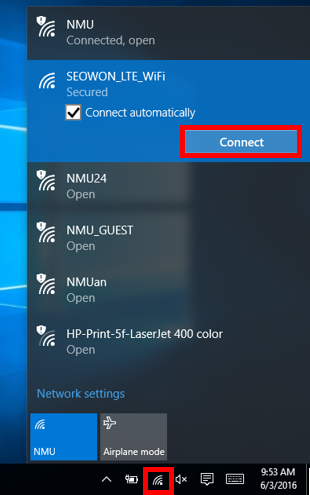
2. Open a web browser and type in this address into the address field: “192.168.2.1” for WiFi connection to the SLC-120 (or “192.168.1.1” for an Ethernet connection) and press the “Enter” key to access the SLC-120 login screen.
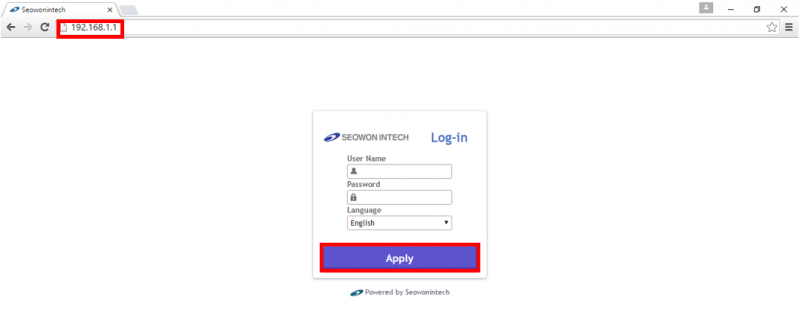
3. Enter the User Name: “user” and the Password: “user” and click the “Apply” button.
4. On the menu on the left side of the window choose; “Settings”, “User Management”, and “Account”.
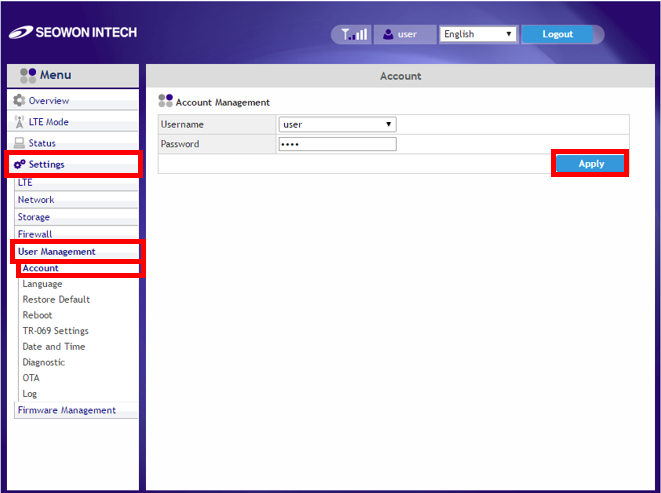
5. Enter a new password in the field provided making sure of each keystroke you typed and be sure to record the password you used, possibly on the label on the bottom of the SLC-120.
Securing SLC-120 WiFi Access (Recommended)
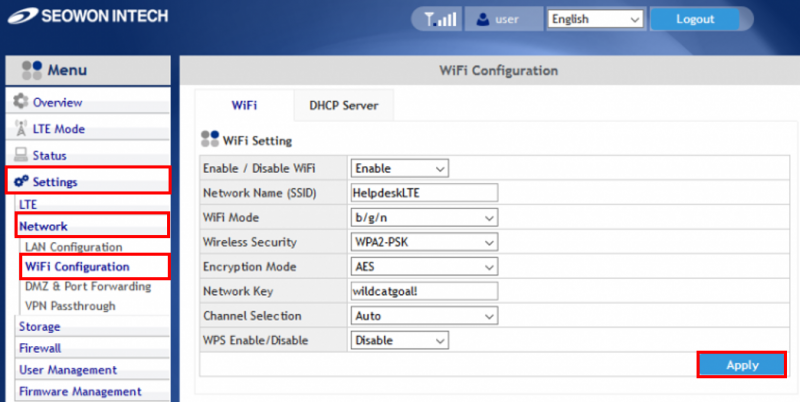
- You could change the “Network Name (SSID)” field if you would like. There can be no spaces in the name.
- In the “Wireless Security” field choose “WPA2-PSK”.
- In the "Encryption Mode" field choose "AES".
- Enter a “Network Key” in the field and be sure to record the network key you used, possibly on the label on the bottom of the SLC-120.
3. You will be prompted “After setting the board will be reboot. Do you want to continue?” Click “OK”.

4. The SLC-120 will take a minute to restart. Once it restarts the screen will appear to freeze.
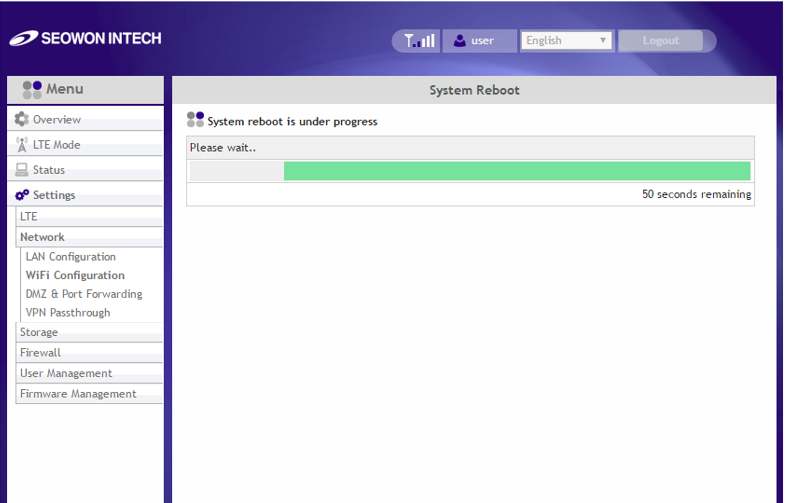
5. If you were connected via WiFi you will need to re-establish a connection to the SLC-120 using the “SEOWON_LTE_WiFi” access point name or the new name if you changed it and the new Network Key you entered.
6. Verify you have Internet access using the WiFi connection.
Checking LTE Signal Strength

2. Open a web browser and type in this address into the address field: “192.168.2.1” for WiFi connection to the SLC-120 (or “192.168.1.1” for an Ethernet connection) and press the “Enter” key to access the SLC-120 login screen.

3. Enter the User Name: “user” and the Password: “user” and click the “Apply” button.
4. On the menu on the left side of the window choose; “Status”, “LTE”, and “LTE Stutus” tab toward the top right of the window.
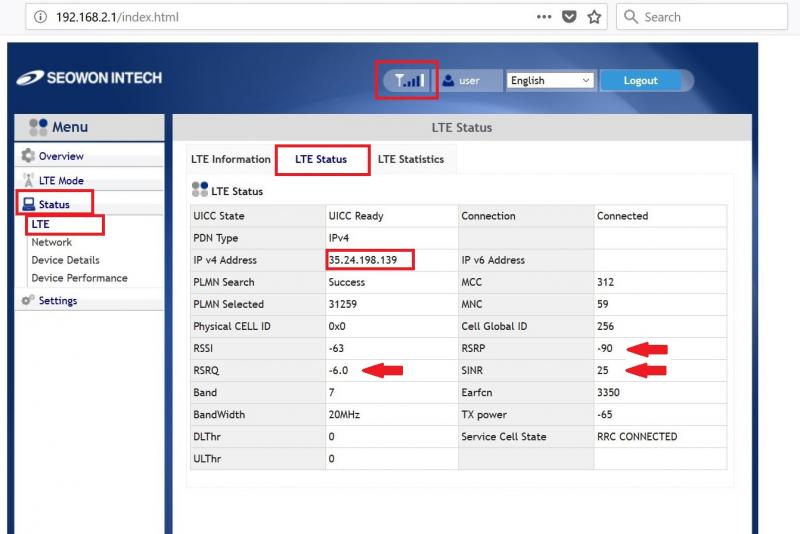
5. The 3 arrows indicate the readings that indicate LTE signal strength. Write them down and also note the IP address.
| RSRP | RSRQ | SINR | |
| Excellent | > - 90 | > -9 | > 10 |
| Good | -90 to -105 | -9 to -12 | 6 to 10 |
| Fair | -105 to -120 | < -11 | 0 to 5 |
| Poor | < -120 | < 0 |
Using the Reset Button
The reset button located on the bottom of the SLC-120 will set the web interface back to the factory defaults with “user” for the password, no WiFi encryption and any other changes you may have set up. This is a good choice if you have forgotten what the settings were. Using the reset button does not erase any of the NMU LTE connection information.
